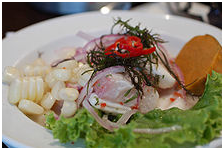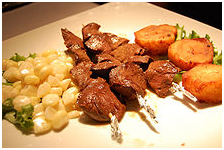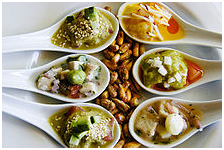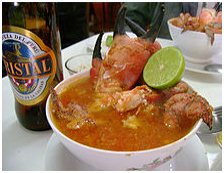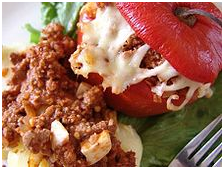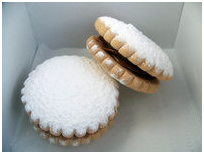Peruvian Cuisine

|
Peruvian Cuisine
Peruvian cuisine stems mainly from the combination of Spanish cuisine with traditional native Peruvian ingredients, with later influences brought in by immigrants from China, Italy, West Africa and Japan. The three traditional staples of Peruvian cuisine are corn, potatoes and beans. These ingredients have been combined with a number of staples brought by the Spanish, such as rice, wheat and meat - such as beef, pork and chicken. Many traditional foods, such as quinoa, kiwicha, chili peppers and several roots and tubers which had been pushed aside for European products, have seen a resurgence in popularity in recent decades with a revival of interest in native Peruvian food crops. 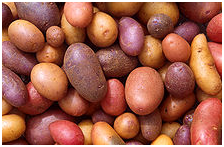  Peruvian potatoes and Peruvian corn
Peru is considered an important center for the genetic diversity of the world's crops: Maize (corn), 35 varieties. Tomatoes, 15 species. Potatoes, 200 species of potato are native to the Andes region. Over 99% of all cultivated potatoes worldwide are descendants of a subspecies indigenous to south-central Chile, namely Solanum tuberosum. This subspecies has developed into thousands of varieties that vary by size, shape, color, and other sensory characteristics. Sweet potatoes, 150 varieties. Peanuts are native to Peru and were taken by Spanish and Portuguese merchants to Africa. Fruits, about 20 native varieties exist which are used in Peru as food.
Ceriche Mixto, Anticuchos and Tiradito Lomo saltado, Chicharron and Papa rellena
Empanadas and Ceviche sampler Pachamanca, Chupe and Rocoto Relleno
Sweets include - Alfajores and Suspiro a la limena
Alfajores: a dessert found in virtually all of Spain's former colonies. It is derived from the versions popular in Spain during the colonial period. The original Spanish recipes, however, have been modified due to the fact that the original ingredients are expensive in Peru (almonds, honey) or even unobtainable (hazlenuts, lemon rind, coriander seed, etc.). The basic recipe makes use of a base mix of flour, key lime rind, margarine, and powdered sugar which is then oven-baked. Alfajores consist of two or more layers of this baked pastry, and is usually filled with either manjar blanco (a caramel-colored, sweet, creamy filling made with milk and sugar) or molasses. Suspiro a la Limena: Another Spanish influenced dessert due to the presence of Dulce de leche which was derived from the Spanish Blancmange. The bottom layer is made of dulce de leche that has been enriched with egg yolks. The top layer consists of meringue made with port wine. This classic criollo dessert is said to have been named by the famous Peruvian poet and author Jose Galvez whose wife dona Amparo Ayarez was famous for her cooking. When asked what inspired the name, he reportedly replied ‘because it is soft and sweet like the sigh of a woman’. In this case, it would be a woman from Lima, a Limena.
Pisco Sour, a kind of brandy, is the national drink of Peru. It originated during the colonial period as a cheaper substitute for the Spanish liquor known as Orujo which is made in virtually the same manner. This distilled beverage made from grapes is produced in various regions of the country. Pisco Sour is a cocktail made from pisco combined with key lime juice, the white of an egg and sugar. Our first Pisco Sour was a welcome drink when we arrived in Miraflores. We then HAD to check out this drink in each new town, as a comparison test - regional variation, size, colour, egg white top, for no other reason of course................
ALL IN ALL I DID MY BEST TO BE BRAVE SURPRISING AND INTERESTING - GOOD TO TRY |
